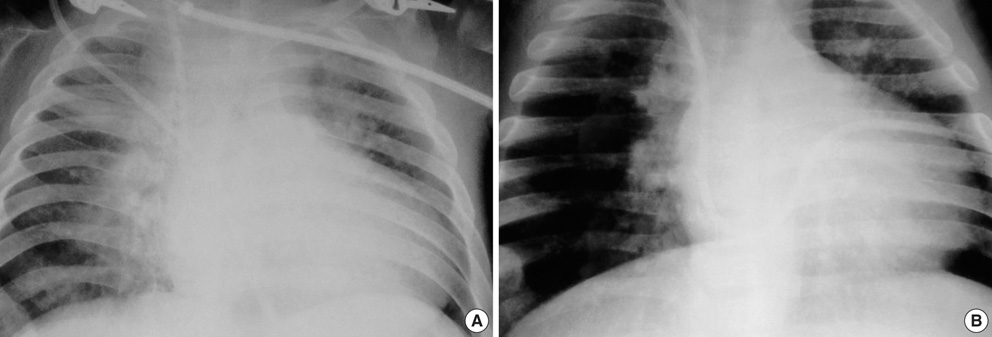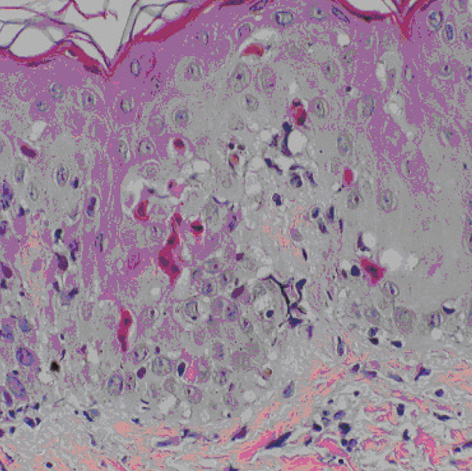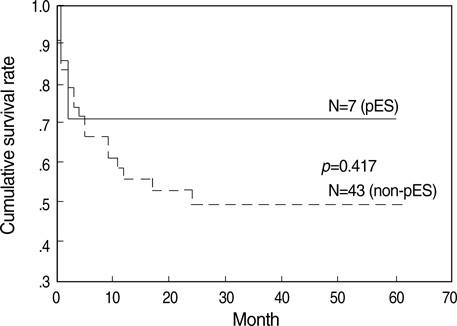J Korean Med Sci.
2008 Feb;23(1):98-103. 10.3346/jkms.2008.23.1.98.
Pre-engraftment Syndrome in Hematopoietic Stem Cell Transplantation
- Affiliations
-
- 1Department of Pediatrics & Hematopoietic Stem Cell Transplantation Center, Hanyang University Medical Center, Seoul, Korea. cord@hanyang.ac.kr
- 2Inje University Baik Hospital, Seoul, Korea.
- 3Dong-A University Medical Center, Busan, Korea.
- KMID: 1786853
- DOI: http://doi.org/10.3346/jkms.2008.23.1.98
Abstract
- The clinical findings of fever and skin rash with or without evidence of fluid retention, which mimic engraftment syndrome, have been observed during the pre-engraftment period in patients undergoing hematopoietic stem cell transplantation. In order to characterize this newly observed clinical syndrome called pre-engraftment syndrome (pES), we retrospectively analyzed the clinical records of 50 patients. Three out of 14 patients (23.1%) who underwent cord blood stem cell transplantation developed non-infectious fever, skin rash, and tachypnea 4-15 days prior to neutrophil engraftment. Two patients spontaneously recovered with fluid restriction and oxygen inhalation. One patient died of a complicated pulmonary hemorrhage in spite of aggressive supportive therapy and steroid treatment. Four out of 23 patients (17.4%) who underwent allogeneic bone marrow transplantation developed non-infectious fever and skin rash 4 to 5 days prior to neutrophil engraftment. All four of these patients recovered with only steroid treatment. These characteristic findings were not observed in patients who had undergone autologous peripheral blood stem cell transplantation. Interestingly, the speed of neutrophil engraftment was significantly faster for the patients suffering from pre-engraftment syndrome. The close observation and further pathophysiological research are required to better understand this syndrome.
MeSH Terms
Figure
Cited by 1 articles
-
Pre-engraftment syndrome: clinical significance and pathophysiology
Young-Ho Lee, Wee-Jin Rah
Blood Res. 2016;51(3):152-154. doi: 10.5045/br.2016.51.3.152.
Reference
-
1. Alexander SW, Walsh TJ, Frifeld AG, Pizzo PA. Pizzo PA, Poplack DG, editors. Infectious complications in pediatric cancer patients. Principles and practice of pediatric oncology. 2002. 4th ed. Lippincott Williams & Wilkins Co;1239–1283.2. Dickout WJ, Chan CK, Hyland RH, Hutcheon MA, Fraser IM, Morgan CD, Curtis JE, Messner HA. Prevention of acute pulmonary edema after bone marrow transplantation. Chest. 1987. 92:303–309.
Article3. Lee CK, Gingrich RD, Hohl RJ, Ajram KA. Engraftment syndrome in autologous bone marrow and peripheral stem cell transplantation. Bone Marrow Transplant. 1995. 16:175–182.4. Maiolino A, Biasoli I, Lima J, Portugal AC, Pulcheri W, Nucci M. Engraftment syndrome following autologous hematopoietic stem cell transplantation: definition of diagnostic criteria. Bone Marrow Transplant. 2003. 31:393–397.
Article5. Colby C, McAfee S, Sackstein R, Dey B, Saidman S, Sachs DH, Sukes M, Spifzer TR. Engraftment syndrome following nonmyeloablative conditioning therapy and HLA-matched bone marrow transplantation for hematologic malignancy. Blood. 2000. 96:520a.6. Canninga-van Dijk MR, Sanders CJ, Verdonck LF, Fijnheer R, van den Tweel JG. Differential diagnosis of skin lesions after allogeneic haematopoietic stem cell transplantation. Histopathology. 2003. 42:313–330.
Article7. Moreb JS, Kubilis PS, Mullins DL, Myers L, Youngblood M, Hutcheson C. Increased frequency of autoaggression syndrome associated with autologous stem cell transplantation in breast cancer patients. Bone Marrow Transplant. 1997. 19:101–106.
Article8. Sutkowi L, Pohlman B, Kalaycio B, Andresen S, Lichtin A, Goormastic M, McBee D, DeMars E, Kephart B. Clinical correlations of the engraftment syndrome. Blood. 1999. 94:146a.9. Edenfield WJ, Moores LK, Goodwin G, Lee N. An engraftment syndrome in autologous stem cell transplantation related to mononuclear cell dose. Bone Marrow Transplant. 2000. 25:405–409.
Article10. Ravoet C, Feremans W, Husson B, Majois F, Kentos A, Lambermont M, Wallef G, Capel P, Beauduin M, Delannoy A. Clinical evidence for an engraftment syndrome associated with early and steep neutrophil recovery after autologous blood stem cell transplantation. Bone Marrow Transplant. 1996. 18:943–947.11. Cahill RA, Spitzer TR, Mazumder A. Marrow engraftment and clinical manifestations of capillary leak syndrome. Bone Marrow Transplant. 1996. 18:177–184.12. Moore MA. Review: Stratton Lecture 1990. Clinical implications of positive and negative hematopoietic stem cell regulators. Blood. 1991. 78:1–19.
Article13. Jadus MR, Wepsic HT. The role of cytokines in graft-versus-host reactions and disease. Bone Marrow Transplant. 1992. 10:1–14.14. Takamatsu Y, Akashi K, Harada M, Teshima T, Inaba S, Shimoda K, Eto T, Shibuya T, Okamura S, Niho Y. Cytokine production by peripheral blood monocytes and T cells during haemopoietic recovery after intensive chemotherapy. Br J Haematol. 1993. 83:21–27.
Article
- Full Text Links
- Actions
-
Cited
- CITED
-
- Close
- Share
- Similar articles
-
- Pre-engraftment Syndrome in Allogeneic Hematopoietic Stem Cell Transplantation
- A Study of the Factors Affecting the Term of Engraftment During Hematopoietic Stem Cell Transplantation with a Focus on the Inhibitors of Oral Intake and the Period of Nutritional Support
- Evans Syndrome Following Unrelated Bone Marrow Transplantation
- Risk factors for mortality in patients with bloodstream infections during the pre-engraftment period after hematopoietic stem cell transplantation
- Infectious complications after hematopoietic stem cell transplantation: current status and future perspectives in Korea




